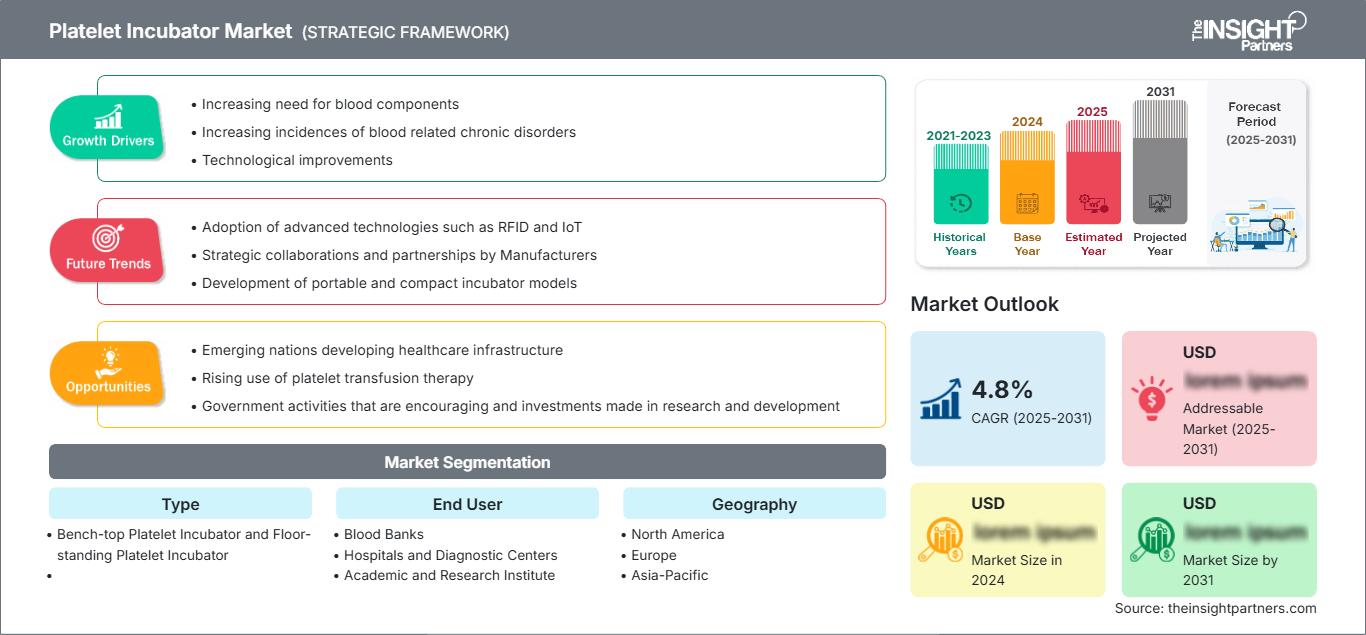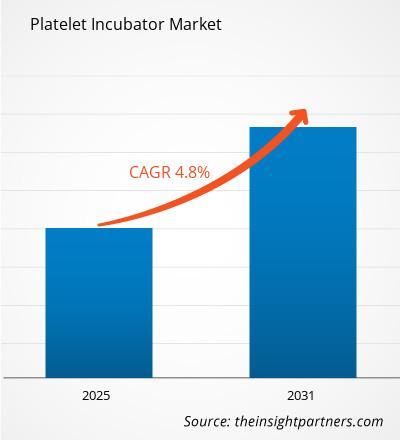页面已更新 :
Jan 2025
预计到 2031 年,血小板培养箱市场规模将达到 6.1383 亿美元。预计 2025 年至 2031 年期间,该市场将以 4.9% 的复合年增长率增长。
本报告按类型(台式血小板培养箱和落地式血小板培养箱)进行细分。报告还根据最终用户(血库、医院和诊断中心、学术和研究机构以及其他最终用户)进行分析。全球分析进一步细分至区域和主要国家。报告以美元为单位提供上述分析和细分市场的价值。
报告目的
The Insight Partners发布的《血小板培养箱市场报告》旨在描述当前市场格局和未来增长趋势、主要驱动因素、挑战和机遇。该报告将为各类商业利益相关者提供参考,例如:
- 技术提供商/制造商:了解不断变化的市场动态和潜在的增长机会,从而能够做出明智的战略决策。
- 投资者:对市场增长率、市场财务预测以及整个价值链中存在的机会进行全面的趋势分析。
- 监管机构:监管市场政策和执法活动,旨在最大限度地减少滥用行为,维护投资者信任和信心,维护市场的诚信和稳定。
血小板培养箱市场细分类型
- 台式血小板培养箱和落地式血小板培养箱
最终用户
- 血库
- 医院和诊断中心
- 学术与研究机构
- 其他最终用户
根据您的需求定制此报告
您可以免费获得任何报告的定制服务,包括本报告的部分内容、国家/地区层面的分析、Excel 数据包,以及面向初创企业和高校的优惠折扣。
血小板培养箱市场:战略洞察

- 获取本报告的主要市场趋势。这份免费样品将包含数据分析,内容涵盖市场趋势、估算和预测等。
血小板培养箱市场增长驱动因素
- 血液成分需求日益增长:由于大多数输血机构,尤其是儿科和外科手术机构,对血小板的需求不断增长,因此血液成分采集过程中对血小板培养箱的需求也随之增加。许多医院和血库在维持充足的血小板供应以满足即将接受手术或癌症治疗的患者的输血需求方面面临困难,因此,妥善储存和处理血小板变得至关重要。
- 血液相关慢性疾病发病率不断上升:如今,与血液和造血相关的疾病,包括白血病、贫血和血小板减少症,在患者中越来越常见。因此,对血小板培养箱的需求也在不断增长。在治疗这些患者的过程中,另一项常规操作是输注血小板,因此,医院和血库需要高效的储存设施来保护用于输注的血小板的完整性和安全性。
- 技术进步:更精确的温度控制确保储存的血小板处于理想状态,从而延长其存活时间。新一代产品更加节能,因此在医疗机构运行成本更低。技术进步无疑是血小板培养箱市场需求增长的关键因素。新型设计和功能提升了培养箱的性能和效率,凸显了其在血库和医院中的重要性。
血小板培养箱市场未来趋势
- 采用RFID和物联网等先进技术:将物联网技术集成到血小板培养箱中,可以实时监测温度、湿度以及其他关键参数。这将确保理想的储存条件,并提高血小板的安全性和有效性。RFID技术有助于无缝追踪血小板库存。轻松监测库存水平、有效期和使用模式有助于减少浪费,并提高医疗机构的及时补货能力。事实上,目前血小板培养箱市场的一大趋势就是采用RFID和物联网等最新技术。
- 制造商间的战略合作与伙伴关系:制造商与研究机构的合作将有助于推动血小板培养箱等高新技术和创新设计的发展。企业间的合作则可能为参与者提供机会,使其能够利用对方的分销网络和地理信息,开拓新的市场或地区。事实上,战略合作与伙伴关系是目前血小板培养箱市场的发展趋势。
- 便携式和小型培养箱的研发:便携式培养箱便于移动,因此可以在多种情况下使用血小板,包括紧急情况、偏远地区或医疗机构间转运。对于空间有限的医疗机构而言,紧凑型设计至关重要。这些培养箱可以放置在狭小的空间内,同时保持血小板储存所需的适宜环境条件。事实上,便携式和小型培养箱是血小板培养箱市场的一大发展趋势。
血小板培养箱市场机遇
- 新兴国家正在发展医疗卫生基础设施:医疗设施和服务的扩张需要更多的血液成分,例如血小板,因此需要安全的储存方式。此外,在发展中国家新建或扩建血库需要血小板培养箱来妥善储存这些血液成分。政府、非政府组织和私营部门的合作也将促进对医疗卫生基础设施(包括血液储存技术)的投资。新兴经济体医疗卫生基础设施的改善将为血小板培养箱市场带来绝佳机遇。
- 血小板输注疗法使用量不断增长:癌症和血液疾病治疗手术及相关治疗的需求日益增长,将带动血小板输注需求的增加。预计需要血小板输注疗法的患者人数增长将对优质储存解决方案的需求产生积极影响。更完善的献血计划促进了血小板采集量的增加,而开发充足的储存基础设施的需求也与此增长相匹配。血小板输注疗法的激增无疑为血小板培养箱市场参与者创造了新的机遇。
- 政府鼓励研发活动及投资:越来越多的政府正在制定预算,以改善医疗设施,例如血库和医院。这需要更先进的血小板储存解决方案。政府通常会向致力于开发可用于血液成分储存和输注的新技术以及改进血小板培养箱设计和功能相关方面的机构和公司提供资助。政府通过研发开展的活动和投资,对血小板培养箱市场的增长起到了催化作用。
血小板培养箱市场区域洞察
The Insight Partners 的分析师对预测期内血小板培养箱市场的区域趋势和影响因素进行了详尽的阐述。本节还探讨了北美、欧洲、亚太、中东和非洲以及南美和中美洲等地区的血小板培养箱市场细分和地域分布情况。
血小板培养箱市场报告范围
| 报告属性 | 细节 |
|---|---|
| 2024年市场规模 | XX百万美元 |
| 到2031年市场规模 | 6.1383亿美元 |
| 全球复合年增长率(2025-2031年) | 4.9% |
| 史料 | 2021-2023 |
| 预测期 | 2025-2031 |
| 涵盖部分 | 按类型
|
| 覆盖地区和国家 | 北美
|
| 市场领导者和主要公司简介 |
|
血小板培养箱市场参与者密度:了解其对业务动态的影响
血小板培养箱市场正快速增长,主要受终端用户需求不断增长的推动,而这又源于消费者偏好的转变、技术的进步以及消费者对产品优势认知的提高。随着需求的增长,企业不断拓展产品线、创新以满足消费者需求并把握新兴趋势,这些都进一步推动了市场增长。

- 获取血小板培养箱市场主要参与者概览
主要卖点
- 全面覆盖:该报告全面分析了血小板培养箱市场的产品、服务、类型和最终用户,提供了一个全面的市场概况。
- 专家分析:该报告是根据行业专家和分析师的深入理解编制的。
- 最新信息:该报告涵盖了最新的信息和数据趋势,确保了其与业务的相关性。
- 定制选项:本报告可根据客户的具体需求进行定制,并能恰当地适应业务战略。
因此,这份关于血小板培养箱市场的研究报告有助于深入了解和解读行业现状及增长前景。尽管其中可能存在一些合理的担忧,但总体而言,这份报告的优势远大于劣势。
- 历史分析(2 年)、基准年、预测(7 年)及复合年增长率
- PEST和SWOT分析
- 市场规模、价值/数量 - 全球、区域、国家
- 行业和竞争格局
- Excel 数据集
近期报告
客户评价
购买理由
- 明智的决策
- 了解市场动态
- 竞争分析
- 客户洞察
- 市场预测
- 风险规避
- 战略规划
- 投资论证
- 识别新兴市场
- 优化营销策略
- 提升运营效率
- 顺应监管趋势
我们的客户































87-673-9708

ISO 9001:2015



 获取免费样品 - 血小板孵化器市场
获取免费样品 - 血小板孵化器市场